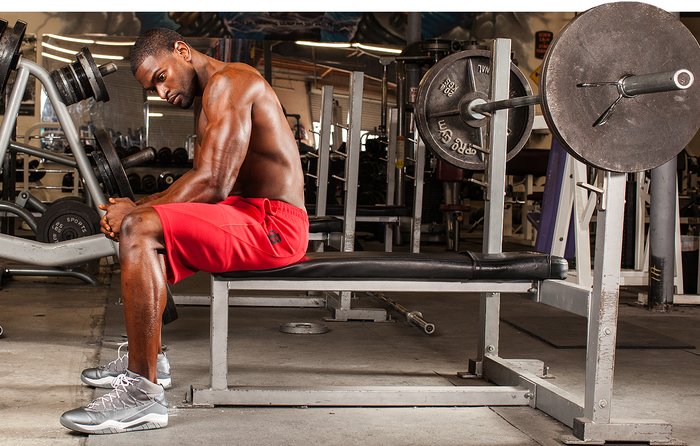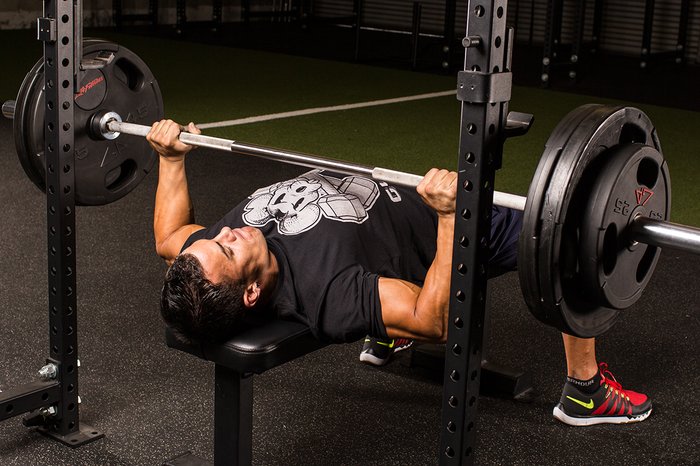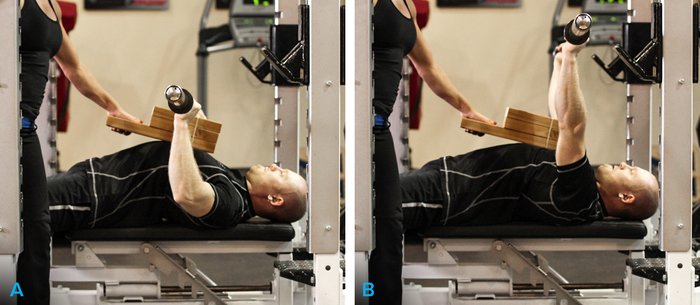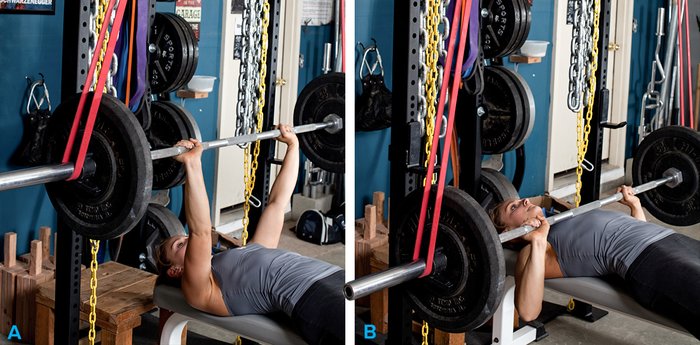Almost nothing feels better than beating your old bench-press mark. And while it may have happened regularly during your early days of lifting, those fast gains start slowing down as you become more seasoned. Pretty quickly, you'll require a more disciplined approach than simply getting under a heavy bar and pushing with everything you've got.
If your bench-press gains have stalled, it's time to examine some proven approaches that can get you back on track again. They address specific weak links along the movement, giving you help where you need it most.
In The Beginning, There Was Form
Before we dissect the bench press and its associated maladies, let's first make sure your form is dialed in. Poor form is often misattributed to weakness (this applies to many other lifts, by the way). However, you might not need to work on improving your bench-press starting strength or lockout; you may instead simply need to tighten up your form.
A long-winded diatribe on the intricacies of the bench press is beyond this article. I can, however, hammer home the necessities. Make sure you have these points down before diving any deeper into assistance training:
- Straight wrists, knuckles pointed to the ceiling
- Eyes under the bar before unracking it
- Feet in a position where they can forcefully drive into the ground
- Glutes tight
- Bar squeezed as hard as possible
- Bar touching a position on your chest that keeps the elbows underneath the bar
- Elbows underneath the bar for the entire press
If you can confidently check off all the items on this list, you're ready to talk about selecting assistance lifts. If not, work on getting better at the full-range barbell bench press. Once you've mastered that, come back to this article for assistance advice.
Identifying The Problem
Now put on your Sherlock Holmes hat and do some sleuth work. There are no arbitrary assistance solutions; you must investigate to find the problem, and then plan assistance training based on the evidence.

Bench pressers must overcome two weak areas: the start and the finish.
Bench pressers must overcome two weak areas: the start and the finish. Lots of ladies and gents can lock out a Volkswagen, but they have a hard time getting the bar to launch out of the bottom position. Some exist at the other end of the spectrum: They rocket weight off the chest, only to fail as the press progresses into the mid- and upper-range.
If you're unsure which describes you, have someone film you doing a heavy bench-press set. Warm-up to about 90 percent of your 1-rep max, and press it for as many reps as you can. When you've finished, watch the video and note where you begin to struggle. Then note where you begin to fail on your last rep. You'll get an instant visual of which group you belong in.
Group 1: Trouble Off The Chest
Do you have a hard time getting the party started? In most cases, you can best address this by either picking up the pace with some dedicated speed work, or doing the absolute opposite and hanging out for a few interminable seconds at the bottom of the bench-press range of motion. Here's how to program both.
Speed Bench Press
The speed/dynamic-effort bench press is a powerlifting staple popularized decades ago by Louie Simmons of Westside Barbell. It's a great means for increasing bench-pressing volume without overtraining, while also improving speed off the chest.
You'll do this by progressing the speed bench press for one month, doing lots of sets of just a few reps with 50-60 percent of your 1-rep max. For example, if your max bench press is 275 pounds, you'll use just 135 pounds during the first week.

Speed Bench Press
Set it up like this:
- Week 1: 6 sets of 3 reps at 50 percent 1RM
- Week 2: 6 sets of 3 reps at 55 percent 1RM
- Week 3: 8 sets of 3 reps at 55 percent 1RM
- Week 4: 6 sets of 3 reps at 60 percent 1RM
Make the speed bench your main bench-pressing movement one day per week, or your first-level assistance exercise after your heavy bench presses. If you choose to use the speed bench as a main exercise, bench heavy on one other upper-body training day per week, keeping the loads between 80-85 percent.
Paused Bench Presses
An isometric pause in the bottom bench-press position does wonders for building strength and power out of the hole. That's because under normal conditions, when you reverse direction out of the hole, built-up elastic energy helps propel you over the bottom portion of the lift. But when you stop at the bottom momentarily, that built-up energy is lost, so you now have to work harder getting the bar out of the hole.
The process is simple. Use loads between 80-90 percent of your 1RM and pause for 3-5 seconds in the bottom position, holding the bar slightly off your chest while maintaining full-body tension. Once you've paused for the prescribed time, press the bar as fast as possible.

Paused Bench Press
This method works well in conjunction with speed bench presses, by the way. Perform the paused reps on your other weekly bench-press day.
Here's a simple way to program paused bench presses:
- Week 1: 4 sets of 3 reps at 80 percent of your 1RM with 4-second pause
- Week 2: 4 sets of 3 reps at 85 percent of your 1RM with 3-second pause
- Week 3: 5 sets of 3 reps at 85 percent of your 1RM with 3-second pause
- Week 4: 3 sets of 3 reps at 80 percent of your 1RM with 5-second pause
Remember, you need to know you one-rep max for the bench press, and then simply multiply it by the percentage you're doing that week. That becomes the load for all your sets.
Group 2: Trouble At The Finish
So you can blast the weight off the chest, but falter at lockout? I have solutions for you as well. In both of these cases, you'll be overloading the top of the bench-press movement.
Board Presses
Like the speed bench, the board press is a powerlifting staple. Bench-press boards are two-by-four or two-by-six planks that are nailed, screwed, or taped together and placed on your chest to shorten the bench-press range of motion, so you're doing only the upper half of the lift. Once the boards are placed on your chest (and usually held there by a lifting partner), you bring the bar down to touch the boards, and then press it back up.

Board Press
Board presses do a couple of things for a poor lockout. First, they allow you to use more weight than normal bench-press sets do. This overloads the movement and trains the nervous system to handle more weight during full-range efforts. They also help you practice pressing through your deficient range of motion. The combination is deadly.
Board presses are a great main bench-press exercise, but they're also great as a first-level assistance exercises, meaning they're done immediately after finishing all of your normal bench-press sets.
I've found three-board two-by-fours or two-by-sixes stacked on one another to be the most productive. They seem to have the best carryover to full-range bench pressing. They also offer have programming versatility, since they work well with heavy sets of 1-5 reps, but are equally great for sets of 5-10 reps.
Let's say your main, full-range bench-press sets are heavy sets of 3 reps, and you're using board presses as your first-assistance exercise. In this case, do 3-5 sets of 5-10 reps.
Reverse-Band Bench Press
Reverse-band bench presses are a full-range bench press with help at the bottom of the movement from elastic training bands. The bands are hooked around the bar and also to the top of a squat rack. This gives you a ton of help out of the bottom position, while requiring you to bear the brunt of the load as the press continues toward lockout.

Reverse-Band Bench Press
These are great for training you to press hard and fast through the full range of motion, while also overloading the press over the top half to train your nervous system to handle heavier weights.
Programming is simple: You program these the same way as board presses. Do 5-10 reps if this movement is a first-assistance exercise, and perform 3-5 sets.
Start Gaining Again
There's an upside to having a stalled bench press: Many people have been where you've been before, and they've come out bigger and stronger on the other side.
Another upside: The methodology isn't complicated. It's almost always one of three points: Improve your form, get stronger out of the bottom, or get stronger at the top. Do your detective work, find the flaw, and then do your reps.

